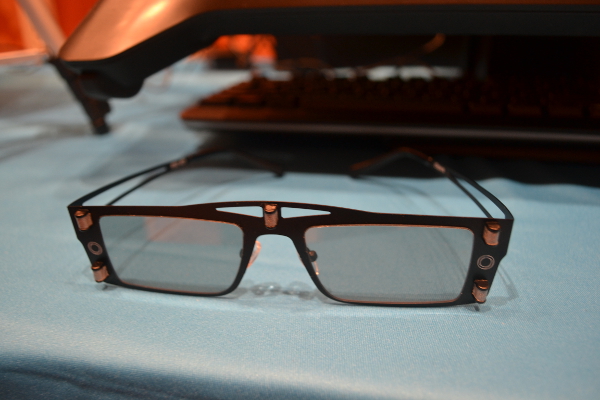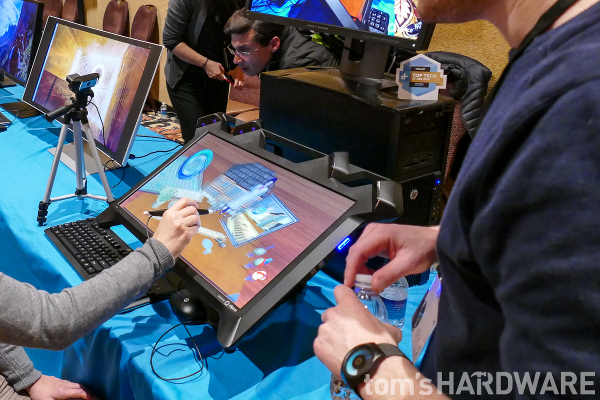Feels Real: Hands And Eyes On HP's Zvr Virtual Reality Display
We've seen enough "new and exciting" tech over the years to know that PR and marketing hype has little to do with how good or bad a product turns out to be (especially when the press photos look abnormally amazing). As a result, we're typically skeptical of any new products that look too good to be true on paper, and when we caught wind of HP's Zvr "virtual reality" display, our hype detector kicked on just a bit.
Withholding judgment until we could see this VR display for ourselves, we visited HP at CES 2015 to see the HP Zvr in person. Rarely does a product exceed our initial expectations, but this delivered.
The specs are solid enough, but they aren't exactly scintillating. As we reported earlier, the device sports a 1920 x 1080 resolution on a 23.6-inch TN panel. It has a 5 ms response time, a USB hub with three ports, DVI (with HDCP) and DisplayPort 1.2.
The VR/AR magic comes via four Intel RealSense 3D cameras mounted along the top of the thick bezel, a pair of glasses equipped with five sensors, and a three-button stylus. The cameras "look" at the glasses and track your head movements.
The glasses are thin and extremely light, and being an already-bespectacled person, I was initially concerned that I wouldn't be able to wear them. However, they fit (awkwardly, but functionally) over my glasses, and I did not have a degraded experience.
My immediate reaction upon donning the glasses was that the demo had remarkable depth. I was just seeing a small desktop with objects lying around. I was able to look around the desktop by leaning in, and as long as the cameras could see the sensors on the glasses, I could see all sides of the objects. When I slid just out of view of the cameras, the images distorted and stretched.
It's neat to poke around like that, but the compelling part involves the stylus. It's a simple-looking thing, about the size of a chunky ballpoint pen, and it has three buttons. Two of them are set side-by-side and function as essentially L and R mouse buttons.
Get Tom's Hardware's best news and in-depth reviews, straight to your inbox.
When the cameras pick up the stylus's emitters (there are two, one at each end), you see a laser-like line with a cursor at the end of it. When you point the cursor here and there, you get what amounts to mouse-on events. Click the stylus button, and you can pick up and move objects around the screen.
I found that the stylus input was instantaneous. There was a very slight lag when I rapidly dragged an object across the screen, but it's important to note that it didn't make me feel dizzy or nauseous in the slightest.
I switched to a demo wherein you see a 3D model of a heart. Using the stylus, I was able to click the whole object and turn it over and over, examining every angle. I could select certain parts and pull them out of the main image; I could click a part to turn it translucent; I could turn off the ability to rotate the image if I so desired; I could right-click with the stylus and select a variety of options; and so on.
To summarize: I felt that I was in complete control of the 3D image -- even more so than if it was physically in my hands, because as a 3D image with multiple controls, there's actually more I could do with it on screen.
I also can't stress enough how intuitive the whole system is to use. With a couple of tips from the HP staff on hand, I was fluidly playing with the demos in just a couple of minutes.
What struck me the most, however, was the strong sense of depth the HP Zvr offered. Moreover, when I used the stylus to drag an object closer to my face, it looked to my eyes exactly like moving a real object.
The best way I can describe it is that the 3D image looked and felt (to my eyes) like a real, physical object. What else can a VR display possibly offer than that?
Actually, there is one thing. We'd love the ability to use our bare hands to do what we did with the stylus. HP reps told us that such functionality is in the plans, although they were not able to specify when that might happen. They said, however, that the issue is something that can be solved through software. Which is to say, the Intel RealSense 3D cameras are technically capable of the task, and it's only a matter of time before HP figures out how to unlock that potential.
Because the HP Zvr is yet technically a protoype (albeit one that's relatively close to release), HP wouldn't elaborate on the system hardware the demos were running on. However, we did learn that the system was a workstation, and minimum recommended specs on the graphics side will be on par with Nvidia K2000 or AMD FirePro 5000 graphics, and you'll need at least a decent Intel Core i5 chip.
I have to reiterate how easy the HP Zvr was to use, how powerful and intuitive the controls were, and how crisp and clean the visuals were. That's not to say that the demos were particularly high res, but they didn't have that motion sickness-inducing look that some VR products have. The images felt real, and I believe I could have spent hours working with the demos before needing to give my eyes and brain a rest.
HP has something compelling with the HP Zvr, and we eagerly anticipate seeing the final product land on the market.
Follow Seth Colaner @SethColaner. Follow us @tomshardware, on Facebook and on Google+.
Seth Colaner previously served as News Director at Tom's Hardware. He covered technology news, focusing on keyboards, virtual reality, and wearables.
-
AndrewJacksonZA You raised the hope in my heart for VR & AR with this article Seth, thanks! :-)Reply -
K-beam ugh, of course this does not create motion/simulator sickness, because the picture does not take 100 of your FOV and does not move with your head, this is to be expected. It's the same as saying "I don't get motion sick when I am sitting in a parked car" :)))Reply -
jt82986 For people wearing glasses, there's a clip-on lens that fits over your own prescription glasses. Maybe HP didn't have it at the show for fear of losing them too easily.Reply -
bit_user Replyugh, of course this does not create motion/simulator sickness, because the picture does not take 100 of your FOV and does not move with your head, this is to be expected.
It does move with your head. That's what the RealSense cameras are for. They allow the image to be re-rendered from your head position.
Systems like this (stereoscopic 3D with head tracking) have been around for over 20 years, but they've been limited to expensive niche applications. It's exciting to see this tech trickle down to the mainstream.
But... it seems like these glasses are passive, which means it will only work for one viewer.
It might seem odd to use something like this when compelling HMDs are also starting to hit the market, but I'd expect this to be a fair bit less fatiguing, and integrate with workflow better than being sealed away in your own virtual cocoon.
-
K-beam Reply15012331 said:ugh, of course this does not create motion/simulator sickness, because the picture does not take 100 of your FOV and does not move with your head, this is to be expected.
It does move with your head. That's what the RealSense cameras are for. They allow the image to be re-rendered from your head position.
Systems like this (stereoscopic 3D with head tracking) have been around for over 20 years, but they've been limited to expensive niche applications. It's exciting to see this tech trickle down to the mainstream.
But... it seems like these glasses are passive, which means it will only work for one viewer.
It might seem odd to use something like this when compelling HMDs are also starting to hit the market, but I'd expect this to be a fair bit less fatiguing, and integrate with workflow better than being sealed away in your own virtual cocoon.
Well, Johnny Lee had that trick 7 years ago with inverted wiimote and IR bar, which is a quite cheap solution https://www.youtube.com/watch?v=Jd3-eiid-Uw
This is an entirely different product from an HMD, so it has its separate place on the market.
What I meant that the image does not move with your head is that if you turn your head 180 degrees, this will still stay at the table. It's more like a window to a virtual 3d world that you can peek through, whereas with an HMD, you are IN the virtual world and there is nothing else. -
scolaner ReplyFor people wearing glasses, there's a clip-on lens that fits over your own prescription glasses. Maybe HP didn't have it at the show for fear of losing them too easily.
Don't quote me on this, but I believe they brought that to the show but had lost it by the time we got to the demo. :)




